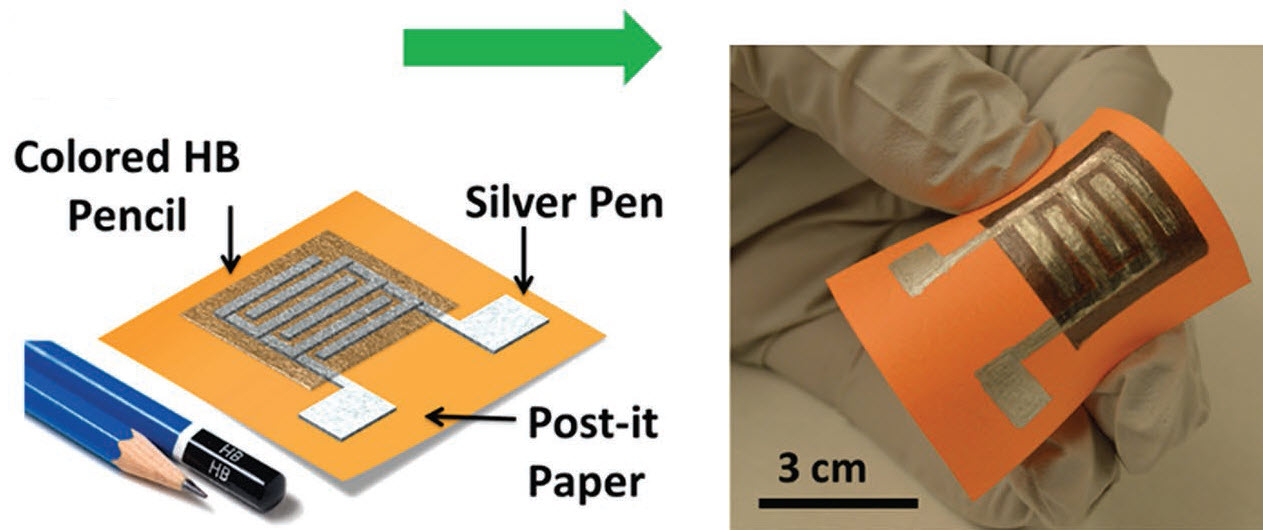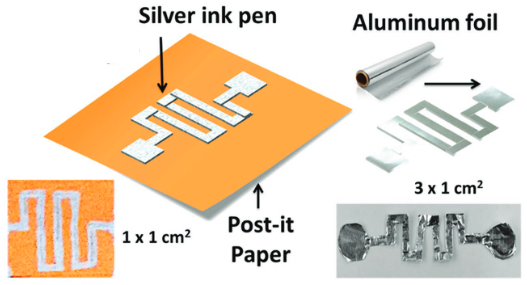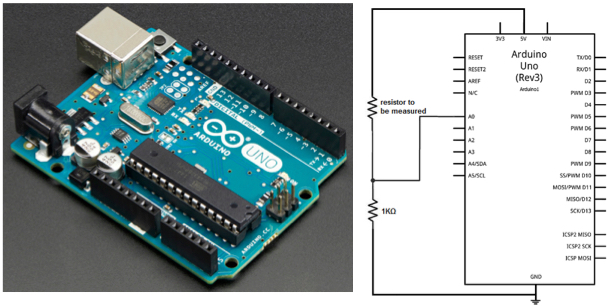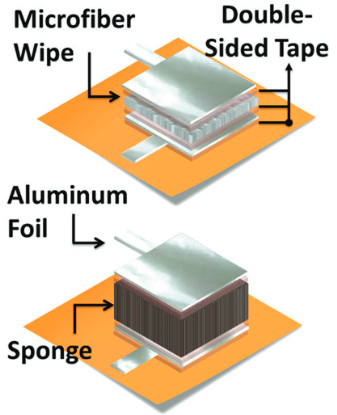Could ‘smart skin’ made of recyclable materials transform medicine and robotics?
February 19, 2016

Capacitive-based disposable pH sensor. The silver pen could be replaced with aluminum foil. (credit: Joanna M. Nassar et al./Advanced Materials Technologies)
Here’s a challenge: using only low-cost materials available in your house (such as aluminum foil, pencil, scotch tape, sticky-notes, napkins, and sponges), build sensitive sensors (“smart skin”) for detecting temperature, humidity, pH, pressure, touch, flow, motion, and proximity (at a distance of 13 cm). Your sensors must show reliable and consistent results and be capable of connecting to low-cost, tiny computers such as Arduino and Raspberry Pi devices.
The goal here is to replace expensive manufacturing processes for creating paper-based sensors with a simple recyclable 3D stacked 6 × 6 “paper skin” array for simultaneous sensing, made solely from household resources, according to Muhammad Mustafa Hussain, senior author of an Advanced Materials Technologies journal open-access paper and professor at King Abdullah University of Science and Technology (KAUST) in Saudi Arabia.
How to create a temperature sensor

Schematic of temperature sensors using aluminum foil or silver ink pen (credit: Joanna M. Nassar/Advanced Materials Technologies)
Creating a highly sensitive temperature sensor requires just two things: a Post-It note and a piece of aluminum foil (a silver ink pen would be more sensitive). A change of temperature would change the resistance of an aluminum strip. To measure the resistance change, connect the sensor to a highly sensitive ohmmeter, using an Arduino Uno, for example. (The output of the Arduino could trigger an alarm, for example.)

Arduino Uno and ohmmeter circuit. The sensor would replace the “resistor to be measured” in the schematic. The bottom resistor value would depend on the sensor resistance range. (credit: Adafruit and Learning About Electronics)
Two designs for a simple pressure sensor

Two designs for a pressure sensor using a parallel-plate structure: (top) Microfiber wipe and sponge; (bottom) more sensitive air-gap structure with sponge. As applied pressure increases, the dielectric thickness decreases, increasing the output capacitance. To measure it, the aluminum foil is connected to a resistor–capacitor circuit (RC circuit), which is connected to an Arduino or Raspberry Pi device to calculate associated pressure change. (credit: Joanna M. Nassar et al./Advanced Materials Technologies)
The simple fabrication process and low-cost materials used “make this flexible platform the lowest cost and accessible to anyone, without affecting performance in terms of response and sensitivity,” Hussain says.
“Democratization of electronics will be key in the future for its continued growth. … This is the first time a [single] platform shows multi-sensory functionalities close to that of natural skin.”
Abstract of Paper Skin Multisensory Platform for Simultaneous Environmental Monitoring
Human skin and hair can simultaneously feel pressure, temperature, humidity, strain, and flow—great inspirations for applications such as artificial skins for burn and acid victims, robotics, and vehicular technology. Previous efforts in this direction use sophisticated materials or processes. Chemically functionalized, inkjet printed or vacuum-technology-processed papers albeit cheap have shown limited functionalities. Thus, performance and/or functionalities per cost have been limited. Here, a scalable “garage” fabrication approach is shown using off-the-shelf inexpensive household elements such as aluminum foil, scotch tapes, sticky-notes, napkins, and sponges to build “paper skin” with simultaneous real-time sensing capability of pressure, temperature, humidity, proximity, pH, and flow. Enabling the basic principles of porosity, adsorption, and dimensions of these materials, a fully functioning distributed sensor network platform is reported, which, for the first time, can sense the vitals of its carrier (body temperature, blood pressure, heart rate, and skin hydration) and the surrounding environment.